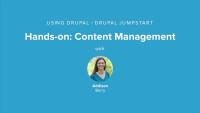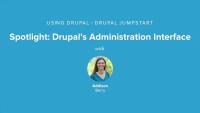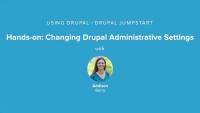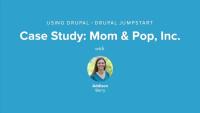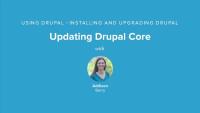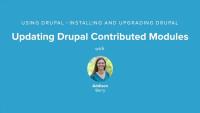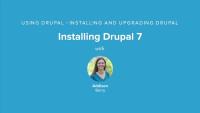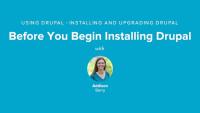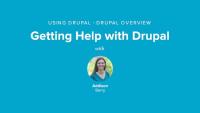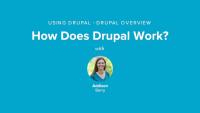In this lesson we're going to start building our site for Mom and Pop, Inc. We're starting off by working on our content, to get things filled out a little. First, we'll create an About Us page with the basic info for the store, like address and opening hours. Then we'll create our first article, which welcomes people to the new site, and see how the two core content types, Basic page and Article, are different from each other. Then we'll tweak our main navigation so our tabs display correctly, and finish things off by looking at block management. We'll remove the "Powered by Drupal" block and add a new block to the site for our weekly specials.
Additional resources
This lesson offers a tour of some of the most basic tools for content management in Drupal. We're going to walk through and explain the following pieces:
- Content
- Comments
- Navigation
- Blocks
Additional resources
In this lesson we're going to start off with the Drupal administrative interface. We'll take a tour of the major elements and get you oriented to what is where.
Additional resources
For this lesson we're going to get hands-on and play around in our administration area a little. We're going to review the site information for our new site, and then change things by setting the site name to match our case study.
Additional resources
This series, from the O'Reilly Media book Using Drupal, Second Edition, is intended for people who are new to Drupal, provides a tour of its capabilities, as well as definitions for its sometimes obscure terminology. We’ll demonstrate how Drupal can be used “out of the box” to build a simple website. Readers who are familiar with Drupal already may still want to skim through this, as later series in the Using Drupal guide will assume knowledge of all content covered here. By the end, you’ll understand how to perform administrative tasks in Drupal, such as configuring modules, working with content types, and setting up site navigation. This series assumes that you already have Drupal up and running. For assistance with that, check out the Appendix A series, on Installing and Updating Drupal, as well as the helpful Drupal.org Getting Started guide.
To get things started with Drupal, we're going to build out a very basic website. The Mom & Pop, Inc. site project will cover many of the basic pieces you need to grasp the fundamentals of building with Drupal, and are a good foundation for the other series we'll be doing from Using Drupal. We'll take a tour through the administrative settings, create and manage content, work with modules and users, as well as changing the look of our new site. In this first lesson in the series we're going to review the Mom & Pop case study and discuss our implementation plan.
Additional resources
This week we get to dig into the first case study from the O'Reilly Media book, Using Drupal, 2nd Edition, with the the Drupal Jumpstart series. This series will walk through Drupal basics by building a simple site for Mom and Pop, Inc. You can watch the overview of our case study for free. We will cover things like the administrative interface, and working with content, comments, menus, and blocks this week.
We're Hiring a Designer
Blog postWe're looking for a web designer to join the Drupalize.Me team. This role is a perfect fit for a great web designer who also has some savvy and interest in product design and marketing. This person will help to create and refine a great user experience for Drupalize.Me members, and will also help create great marketing and promotional materials to tell Drupalize.Me's story to new audiences.
This week we have our third series in the Using Drupal guide, Using Drupal Appendix A: Installing and Updating Drupal. We're skipping ahead to this particular appendix before diving into the case studies to make sure you're ready to go with the basics of getting a Drupal site installed and ready to go.
Updating your site often sounds much scarier than the actual experience is. The most important step to remember is creating and testing backups of your site. In this lesson, we will create our backups, download a new version of Drupal core, and go through the process of updating our files and running the update.php script.
Note: Not mentioned in the video is the fact that in addition to the user 1 account, you can also log in with any account that has the "administer software updates" permission enabled to run the update.php script.
Additional resources
Drupal's contributed projects tend to move more quickly than Drupal core and there- fore require more updates within a Drupal version's life cycle. You can upgrade multiple modules at the same time, although it's best to do one at a time to reduce the chance of errors, and to allow you to isolate problems that might come up during an upgrade. In this lesson we will look at our Available Updates report, and use the Update Manager to upgrade a few of our contributed modules.
Additional resources
Drupal.org Upgrade Documentation
Drupalize.Me Guide: Using Drupal Book by O'Reilly Media
Up next: Using Drupal Appendix B: Choosing the Right Modules
Once you have met all of the requirements and gathered the information you need, you can get down to the installation. This lesson assumes that you have already downloaded Drupal, placed the extracted files on your web server, and are able to create your database.
Additional resources
It’s not enough to just get Drupal installed; you also need to make sure to keep it up-to-date. New releases of modules and Drupal core come out periodically, most of which fix problems, some of which add new whiz-bang features, and some of which address critical security problems. In this lesson we will review Drupal version numbers and what they mean, review the core Update Status module, and then discuss using maintenance mode, and the update.php script.
Note: Not mentioned in the video is the fact that in addition to the user 1 account, you can also log in with any account that has the "administer software updates" permission enabled to run the update.php script.
Additional resources
Prior to installing Drupal, it’s important to make sure that you can actually do so, and understand a bit about how Drupal is structured. The first lesson provides a checklist of Drupal’s requirements, and also highlights important things in the Drupal file structure that are worth knowing before diving into the installation process. We also explain and take a quick look at how you can use Drupal to run multiple sites from the code base, known in Drupal as a multisite installation.
Additional resources
Drupal installation requirements
Podcast Episode 22: Decoupling Drupal
Blog post In the latest episode of the Drupalize.Me podcast, #22 Decoupling Drupal, we chat about what it looks like to separate Drupal's content management from the display of the content, by bypassing the Drupal theme system entirely.
In the latest episode of the Drupalize.Me podcast, #22 Decoupling Drupal, we chat about what it looks like to separate Drupal's content management from the display of the content, by bypassing the Drupal theme system entirely.
Before we jump into building our first Drupal 7 site, we should also take a look at the great resources you have out there to help you on your journey. Being an open source project, Drupal has an amazing community of people who have paved this road before you. In this lesson we're going to look at the free community resources that you can use to not only find answers to your questions, but also connect with thousands of people around the world who are working in the same space you are. -- We are going to take a tour of the communtiy documentation, various Drupal forums, project issue queues, where you can glean a lot of useful information and help, Internet Relay Chat, or IRC, for real-time collaboration, and getting in touch with user groups of like-minded people around the world.
Additional resources
Drupal.org Troubleshooting Guide
Drupal Answers on Stack Exchange
Drupal Groups Site (groups.drupal.org)
Drupal is a great tool for working on the web, but to give it some context, in this lesson we're going to take a quick step back in time, and understand the history of working on the web and look at how the tools that Drupal provides match up with problems encountered over the years of web development.
Additional resources
In this lesson we're going to break down the "Drupal stack" to understand what pieces are working here and how they relate to each other. We'll take a tour of the major components of Drupal itself, like nodes and users, and then have a brief discussion about ways of organizing content.
Additional resources
What Is Drupal?
FreeTo learn more about how to get started with Drupal, also see our Introduction to Drupal guide.
In this lesson we take a look at Drupal, the open source Content Management System. We learn about the major components of a Drupal site and the library of constantly evolving tools available for working with Drupal. We find out how to see who uses it, by looking at DrupalShowcase.com and Drupal case studies on Drupal.org, among others. We look at Drupal's major features, such as Modules.
With this overview we have some context as we move forward into the series.
Additional resources
Drupalcamp Twin Cities
Blog postLive in the Midwest and like Drupal? So do we! Or at least some of our team. And as such we'll be attending the annual Twin Cities DrupalCamp in force this year.
